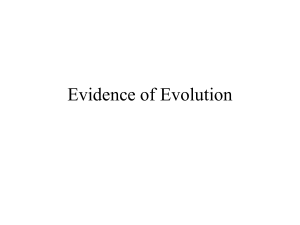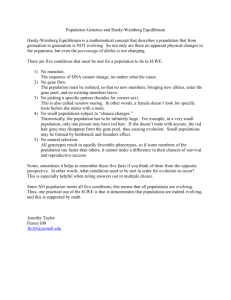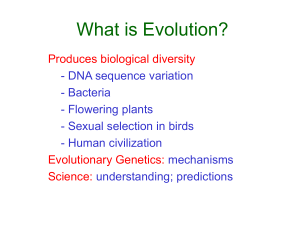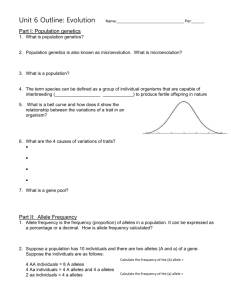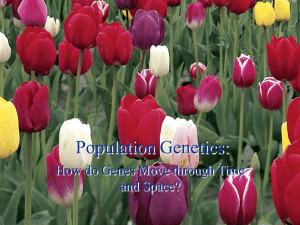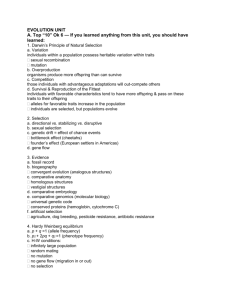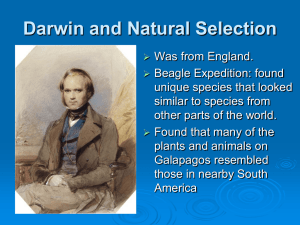Theory of Natural Selection
advertisement
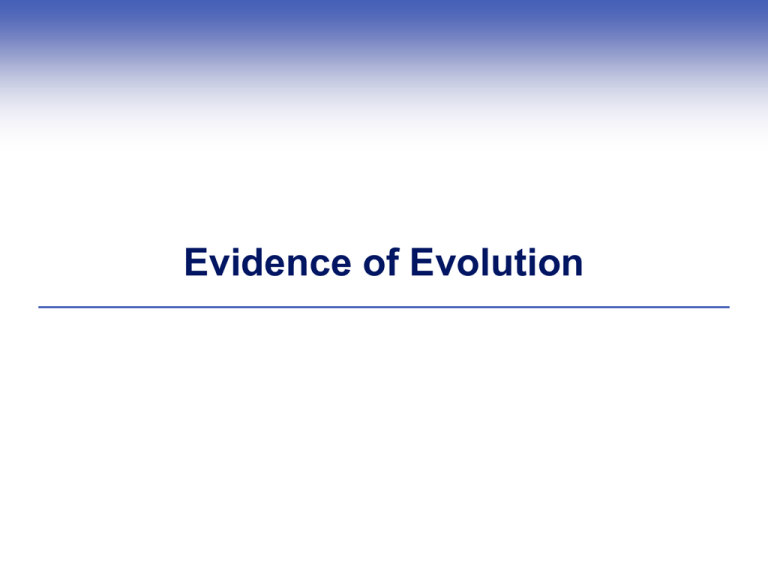
Evidence of Evolution Voyage of the Beagle Charles Darwin’s observations on a voyage around the world led to new ideas about species Voyage of the Beagle Darwin, Wallace, and Natural Selection In 1858, Charles Darwin and Alfred Wallace independently proposed a new theory, that natural selection can bring about evolution Descent with Modification Darwin compared the modern armadillo with the extinct glyptodont Variations in Traits Darwin observed that variations in traits influence an individual’s ability to secure resources – to survive and reproduce Theory of Natural Selection Natural selection • The differential in survival and reproduction among individuals of a population that vary in details of their shared traits • Can lead to increased fitness Fitness • An individual’s adaptation to an environment, measured by its relative genetic contribution to future generations Fossil Evidence Fossils • Physical evidence of life in the distant past Found in stacked layers of sedimentary rock • Younger fossils in more recently deposited layers • Older fossils underneath, in older layers Stratification Fossilization Interpreting the Fossil Record The fossil record is incomplete Favors species with hard parts, dense populations with wide distribution, and that persisted a long time Plate Tectonics Theory Movements of Earth’s tectonic plates rafted land masses to new positions Pangea: First ancient supercontinent • Gondwana (later southern supercontinent) Movements had profound impacts on the directions of life’s evolution Evidence of Drifting Continents Evidence for plate tectonics theory • • • • Distribution of global land masses Global fossil distribution Magnetic rocks Seafloor spreading from mid-oceanic ridges Drifting Continents Biogeographical Evidence Morphological Divergence Homologous structures: Similar body parts that became modified differently in different lineages Evidence of descent from a common ancestor Comparative Morphological Evidence Homologous Structures Analogous Structures DNA, RNA, and Proteins Comparisons of DNA, RNA, and proteins reveal and clarify evolutionary relationships Processes of Evolution Rise of the Super Rats Populations Evolve Population • Individuals of the same species in the same area • Generally the same number and kinds of genes for the same traits Gene pool • All the genes of a population Variation in Alleles Individuals who inherit different combinations of alleles vary in details of one or more traits Mutations are the original source of new alleles • Lethal mutations result in death • Neutral mutations neither help nor hurt Phenotypic Variation in Populations Microevolution Changes in allele frequencies of a population • • • • Mutation Natural selection Genetic drift Gene flow Natural Selection Natural selection • Differential survival and reproduction among individuals of a population that show variations in details of their shared traits (alleles) Allele frequencies • Maintained by stabilizing selection • Shifted by directional or disruptive selection Modes of Natural Selection Peppered Moth Pocket Mice Stabilizing Selection: Birth Weight Sexual Selection Balanced Polymorphism Genetic Drift Genetic drift • Random change in a population’s allele frequencies over time, due to chance • Can lead to loss of genetic diversity Most pronounced in small or inbred populations • Bottleneck: Drastic reduction in population • Founder effect: Small founding group Gene Flow Gene flow • Movement of alleles into or out of a population by immigration or emigration • Helps keep populations of same species similar Counters processes that cause populations to diverge (mutation, natural selection, genetic drift) Gene Flow Between Oak Populations Reproductive Isolation Individuals of a sexually reproducing species can produce fertile offspring, but are reproductively isolated Reproductive isolating mechanisms evolve when gene flow between populations stops Divergences may lead to new species Mechanical Isolation Behavioral Isolation Allopatric Speciation A geographic barrier stops gene flow between two or more populations of a species • Example: Isolated continents or archipelagos Genetic divergence and reproductive isolation give rise to new species Allopatric Speciations An Isolated Archipelago Patterns of Macroevolution Coevolution • Close ecological interactions cause two species to act as agents of selection upon one another Extinction • Irrevocable loss of species • Mass extinctions and recoveries have occurred several times in the history of life • Most species that ever existed are now extinct Coevolution Adaptation to What? Evolutionary adaptation • Heritable traits that improve an individual’s chance of surviving and reproducing (under conditions that prevailed when genes evolved)
